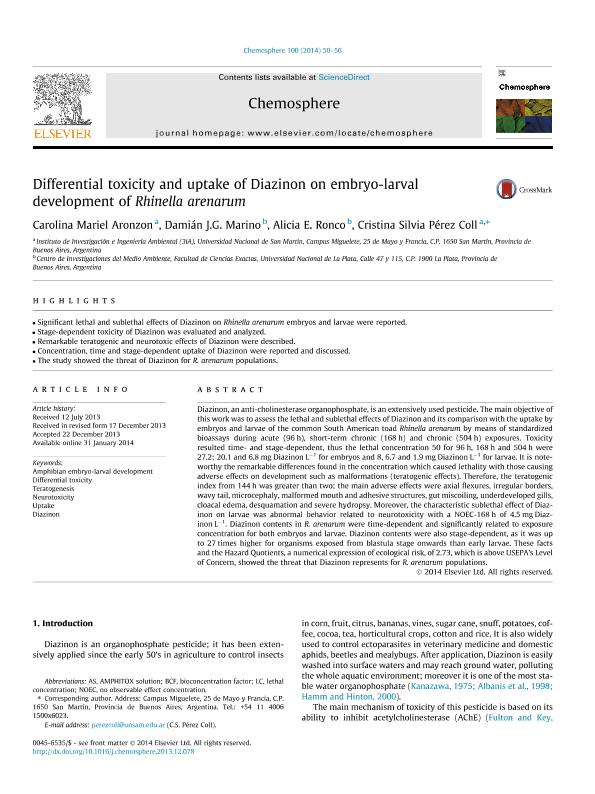Artículo
Differential toxicity and uptake of diazinon on embryo-larval development of Rhinella arenarum
Aronzon, Carolina Mariel ; Marino, Damian Jose Gabriel
; Marino, Damian Jose Gabriel ; Ronco, Alicia Estela
; Ronco, Alicia Estela ; Perez Coll, Cristina Silvia
; Perez Coll, Cristina Silvia
 ; Marino, Damian Jose Gabriel
; Marino, Damian Jose Gabriel ; Ronco, Alicia Estela
; Ronco, Alicia Estela ; Perez Coll, Cristina Silvia
; Perez Coll, Cristina Silvia
Fecha de publicación:
02/2014
Editorial:
Elsevier
Revista:
Chemosphere
ISSN:
0045-6535
Idioma:
Inglés
Tipo de recurso:
Artículo publicado
Resumen
Diazinon, an anti-cholinesterase organophosphate, is an extensively used pesticide. The main objective of this work was to assess the lethal and sublethal effects of Diazinon and its comparison with the uptake by embryos and larvae of the common South American toad Rhinella arenarum by means of standardized bioassays during acute (96 h), short-term chronic (168 h) and chronic (504 h) exposures. Toxicity resulted time- and stage-dependent, thus the lethal concentration 50 for 96 h, 168 h and 504 h were 27.2; 20.1 and 6.8 mg Diazinon L−1 for embryos and 8, 6.7 and 1.9 mg Diazinon L−1 for larvae. It is noteworthy the remarkable differences found in the concentration which caused lethality with those causing adverse effects on development such as malformations (teratogenic effects). Therefore, the teratogenic index from 144 h was greater than two; the main adverse effects were axial flexures, irregular borders, wavy tail, microcephaly, malformed mouth and adhesive structures, gut miscoiling, underdeveloped gills, cloacal edema, desquamation and severe hydropsy. Moreover, the characteristic sublethal effect of Diazinon on larvae was abnormal behavior related to neurotoxicity with a NOEC-168 h of 4.5 mg Diazinon L−1. Diazinon contents in R. arenarum were time-dependent and significantly related to exposure concentration for both embryos and larvae. Diazinon contents were also stage-dependent, as it was up to 27 times higher for organisms exposed from blastula stage onwards than early larvae. These facts and the Hazard Quotients, a numerical expression of ecological risk, of 2.73, which is above USEPA’s Level of Concern, showed the threat that Diazinon represents for R. arenarum populations.
Palabras clave:
Amphibian Embryo-Larval Development
,
Teratogenesis
,
Neurotoxicity
Archivos asociados
Licencia
Identificadores
Colecciones
Articulos(CCT - LA PLATA)
Articulos de CTRO.CIENTIFICO TECNOL.CONICET - LA PLATA
Articulos de CTRO.CIENTIFICO TECNOL.CONICET - LA PLATA
Citación
Perez Coll, Cristina Silvia; Ronco, Alicia Estela; Marino, Damian Jose Gabriel; Aronzon, Carolina Mariel; Differential toxicity and uptake of diazinon on embryo-larval development of Rhinella arenarum; Elsevier; Chemosphere; 100; 2-2014; 50-56
Compartir
Altmétricas



